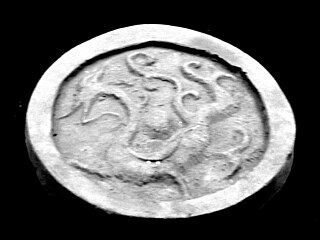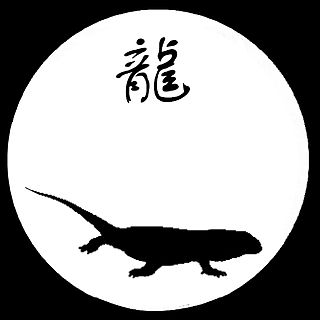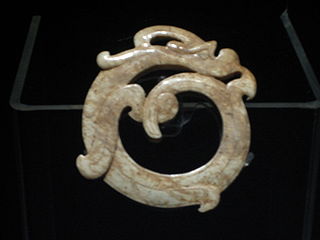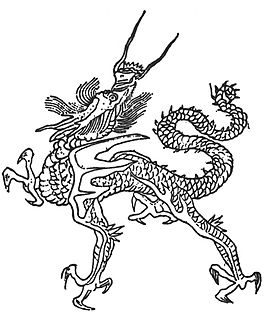 W
WThe Chinese dragon, also known as loong, long or lung, is a legendary creature in Chinese mythology, Chinese folklore, and Chinese culture at large. Chinese dragons have many animal-like forms such as turtles and fish, but are most commonly depicted as snake-like with four legs. Academicians have identifed four reliable theories on the origin of the Chinese dragon: snakes, Chinese alligators, thunder and nature worship. They traditionally symbolize potent and auspicious powers, particularly control over water, rainfall, typhoons, and floods. The dragon is also a symbol of power, strength, and good luck for people who are worthy of it in East Asian culture. During the days of Imperial China, the Emperor of China usually used the dragon as a symbol of his imperial strength and power. In Chinese culture, excellent and outstanding people are compared to a dragon, while incapable people with no achievements are compared to other, disesteemed creatures, such as a worm. A number of Chinese proverbs and idioms feature references to a dragon, such as "Hoping one's child will become a dragon".
 W
WThe Dragon King, also known as the Dragon God, is a Chinese water and weather god. He is regarded as the dispenser of rain as well as the zoomorphic representation of the yang masculine power of generation. He is the collective personification of the ancient concept of the lóng in Chinese culture. He can take a variety of forms, the most important ones being the cosmological Sihai Longwang who, with the addition of the Yellow Dragon of Xuanyuan, represent the watery and chthonic forces presided over by the Five Forms of the Highest Deity, or their zoomorphic incarnation. One of his epithets is Dragon King of Wells and Springs. The dragon king is the king of the dragons and he also controls all of the creatures in the sea. The dragon king gets his orders from the Jade Emperor.
 W
WThe Azure Dragon, also known as Qinglong in Chinese, is one of the Dragon Gods who represent the mount or chthonic forces of the Five Forms of the Highest Deity. He is also one of the Four Symbols of the Chinese constellations, which are the astral representations of the Wufang Shangdi. The Azure Dragon represents the east and the spring season. It is also sometimes referred to as the Blue-green Dragon, Green Dragon, or the Blue Dragon.
 W
WBixi, or Bi Xi, is a figure from Chinese mythology. One of the 9 sons of the Dragon King, he is depicted as a dragon with the shell of a turtle. Stone sculptures of Bixi have been used in Chinese culture for centuries as a decorative plinth for commemorative steles and tablets, particularly in the funerary complexes of its later emperors and to commemorate important events, such as an imperial visit or the anniversary of a World War II victory. They are also used at the bases of bridges and archways. Sculptures of Bixi are traditionally rubbed for good luck, which can cause conservation issues. They can be found throughout East Asia in Japan, Korea, Vietnam, Mongolia, and even the Russian Far East.
 W
WChi means either "a hornless dragon" or "a mountain demon" in Chinese mythology. Hornless dragons were a common motif in ancient Chinese art, and the chiwen 螭吻 was an imperial roof decoration in traditional Chinese architecture.
 W
WThe nine sons of the dragon are Chinese dragons who are the mythological sons of the Dragon King. There are many variations in the different descriptions of the nine sons, including in basic facts like their names, but all versions state that there are nine.
 W
WChiwen is a Chinese dragon, and in Chinese mythology is one of the 9 sons of the dragon. He is depicted in imperial roof decorations and other ornamental motifs in traditional Chinese architecture and art.
 W
WThe Dragon is the fifth of the 12-year cycle of animals which appear in the Chinese zodiac related to the Chinese calendar. The Year of the Dragon is associated with the Earthly Branch symbol 辰, pronounced chen.
 W
WDragon dance is a form of traditional dance and performance in Chinese culture. Like the lion dance, it is most often seen in festive celebrations. The dance is performed by a team of experienced dancers who manipulate a long flexible figure of a dragon using poles positioned at regular intervals along the length of the dragon. The dance team simulates the imagined movements of this river spirit in a sinuous, undulating manner.
 W
WA dragon turtle (Lóngguī) is a legendary Chinese creature that combines two of the four celestial animals of Chinese mythology: the body of a turtle with a dragon's head is promoted as a positive ornament in Feng Shui, symbolizing courage, determination, fertility, longevity, power, success, and support. Decorative carvings or statuettes of the creature are traditionally placed facing the window.
 W
WHong or jiang is a two-headed dragon in Chinese mythology, comparable with rainbow serpent legends in various cultures and mythologies.
 W
WJiaolong or jiao is a dragon in Chinese mythology, often defined as a "scaled dragon"; it is hornless according to certain scholars and said to be aquatic or river-dwelling. It may have referred to a species of crocodile.
 W
WThe longma is a fabled winged horse with dragon scales in Chinese mythology. Seeing a longma was an omen of a legendary sage-ruler, particularly one of the Three Sovereigns and Five Emperors.
 W
WNine Dragons or 九龍圖卷 (陳容) is a handscroll painting by Chinese artist Chen Rong from 1244. Depicting the apparitions of dragons soaring amidst clouds, mists, whirlpools, rocky mountains and fire, the painting refers to the dynamic forces of nature in Daoism. The depicted dragons are associated with nine sons of the Dragon King, while the number nine itself is considered auspicious in Chinese astrology and folk beliefs.
 W
WA Nine-Dragon Wall or Nine-Dragon Screen is a type of screen wall with reliefs of nine different Chinese dragons. Such walls are typically found in imperial Chinese palaces and gardens.
 W
WPanlong is an aquatic dragon resembling a jiaolong 蛟龍 "river dragon; crocodile" in Chinese mythology, an ancient motif in Chinese art, and a proper name.
 W
WA pig dragon or zhūlóng is a type of jade artifact from the Hongshan culture of neolithic China. Pig dragons are zoomorphic forms with a pig-like head and elongated limbless body coiled around to the head and described as "suggestively fetal". Early pig dragons are thick and stubby, and later examples have more graceful, snakelike bodies.
 W
WPulao, known in some early sources also as tulao (徒牢), and Pu Lao, is a Chinese dragon, and one of the 9 sons of the dragon. It is said in Chinese mythology that he likes to "roar", and therefore he is traditionally depicted on top of bells in China, and used as the hook by which the bells are hung.
 W
WQiulong or qiu was a Chinese dragon that is contradictorily defined as "horned dragon" and "hornless dragon".
 W
WTeng or Tengshe is a flying dragon in Chinese mythology.
 W
WTianlong is a flying dragon in Chinese mythology, a star in Chinese astrology, and a proper name.
 W
WThe White Dragon Horse, known as Bai Long Ma in Chinese, is one of the main characters in the 16th-century Chinese novel Journey to the West. He is Tang Sanzang's steed who later became Babu Tianlong Guangli Bodhisattva (八部天龙广力菩萨) at the end of novel.
 W
WThe Yellow Dragon is the zoomorphic incarnation of the Yellow Emperor of the center of the universe in Chinese religion and mythology.
 W
WYinglong is a winged dragon and rain deity in ancient Chinese mythology.
 W
WZhulong or Zhuyin, also known in English as the Torch Dragon, was a giant red solar dragon and god in Chinese mythology. It supposedly had a human's face and snake's body, created day and night by opening and closing its eyes, and created seasonal winds by breathing.